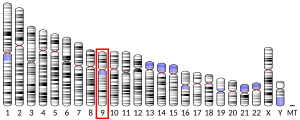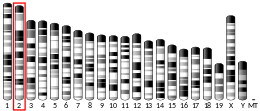PSMB7
PSMB720S 프로테아솜 서브유닛 베타-2로 알려진 프로테아솜 서브유닛 베타-7은 인간에서 PSMB7 유전자에 의해 암호화된 단백질이다.[5][6]
이 단백질은 20S 프로테아솜 콤플렉스의 완전한 조립에 기여하는 17가지 필수 서브유닛(알파 서브유닛 1-7, 구성 베타 서브유닛 1-7, 유도성 서브유닛(베타1i, 베타2i, 베타5i 포함) 중 하나이다.특히 프로테아솜 서브유닛인 베타 타입-5는 다른 베타 서브유닛과 함께 헵타미 링 2개로 조립되고 이후 기질 저하를 위한 프로테아톨리틱 챔버로 조립된다.이 단백질은 "트립신 유사" 활동을 함유하고 있으며, 펩타이드의 기본 잔류물 후 분리가 가능하다.[5]진핵 단백질은 분해성 단백질을 인식했는데, 여기에는 단백질 품질 관리 목적을 위한 손상된 단백질이나 동적 생물학적 과정을 위한 주요 규제 단백질 성분이 포함된다.변형된 프로테아솜의 필수적인 기능인 면역단백제는 클래스 I MHC 펩타이드의 처리다.
구조
유전자
인간 PSMB7 유전자는 8개의 exon을 가지고 있으며 9q34.11-q34.12 염색체 대역에 위치한다.
단백질
PSMB7 유전자는 T1B 계열로도 알려진 프로테아솜 B형 계열의 멤버로, 프로테아솜의 20S 핵심 베타 서브 유닛이다.이 촉매 서브 유닛(beta 2, 체계적 명칭에 따라)의 표현은 유도 서브 유닛 베타2i의 대체적으로 증가된 표현으로 인해 감마 인터페론에 의해 하향 조정되며, 이는 최종 조립된 20S 콤플렉스에 베타2i 대신 베타2i를 증강시킨다.[6]인간 단백질 프로테아솜 서브유닛 베타-7 타입은 크기가 25 kDa이며 234개의 아미노산으로 구성되어 있다.이 단백질의 계산된 이론적 pI는 5.61이다.
복합 조립체
프로테아솜은 20S 코어 구조의 다발성 단백질 분해효소 복합체다.이 배럴 모양의 중심 구조는 28개의 비식별 서브유닛의 축방향으로 쌓은 4개의 링으로 구성되어 있는데, 두 개의 엔드 링은 각각 7개의 알파 서브유닛으로 형성되어 있고, 두 개의 중앙 링은 각각 7개의 베타 서브유닛으로 형성되어 있다.3개의 베타 서브유닛(베타1, 베타2, 베타5)은 각각 단백질 분해 활성 사이트를 포함하고 있으며 기질 선호도가 뚜렷하다.프로테아솜은 높은 농도의 진핵 세포와 클레이브 펩타이드가 비 리소솜 경로에서 ATP/ubiquitin 의존적 공정으로 분산된다.[7][8]
함수
단백질 함수는 3차 구조와 파트너와의 상호작용에 의해 지원된다.단백질 프로테아솜은 20S 프로테아솜 28개 서브유닛 중 하나로, 단백질 프로테아솜 서브유닛 베타-2형은 기질 저하를 위한 프로테아톨리틱 환경을 형성하는 데 기여한다.격리된 20S 프로테아솜 콤플렉스의 결정 구조의 증거는 베타 서브유닛의 두 링이 프로테롤리틱 챔버를 형성하고 챔버 내에서 모든 활성 프로테롤리시스 부위를 유지한다는 것을 보여준다.[8]이와 동시에 알파 서브유닛의 고리는 단백질의 방으로 들어가는 기판을 위한 입구를 형성한다.비활성화된 20S 프로테아솜 콤플렉스에서 내부 프로테아실로의 게이트는 특정 알파 서브 유닛의 N단자 꼬리로 보호된다.이 독특한 구조 설계는 단백질 분해 활성 부위와 단백질 기질 사이의 무작위적인 만남을 방지하여 단백질 저하를 잘 조절된 공정으로 만든다.[9][10]20S 프로테아솜 콤플렉스는 그 자체로 보통 기능적으로 비활성화된다.20S 코어 입자(CP)의 단백질 용량은 CP가 알파 링의 한쪽 또는 양쪽 모두에서 하나 또는 두 개의 규제 입자(RP)와 연결될 때 활성화될 수 있다.이러한 규제 입자에는 19S 프로테아솜 콤플렉스, 11S 프로테아솜 콤플렉스 등이 포함된다.CP-RP 협회에 따라 특정 알파 서브유닛의 확인이 변경되어 결과적으로 기판 출입문이 열리는 원인이 된다.RPs 외에도, 20S 프로테아솜은 낮은 수준의 도데실황산나트륨(SDS) 또는 NP-14에 노출되는 것과 같은 다른 가벼운 화학적 치료에도 의해 효과적으로 활성화될 수 있다.[10][11]
20S 프로테아솜 서브 유닛 베타-2(시스템 명명법)는 원래 277개의 아미노산을 가진 전구체로 표현된다.적절한 단백질 접힘과 그에 따른 복잡한 조립을 위해서는 펩타이드 N단자 내 43개의 아미노산 파편이 필수적이다.복합조립의 말기에는 베타5 서브유닛의 N단자 파편이 갈라져 20S 콤플렉스의 성숙한 베타2 서브유닛을 형성한다.[12]기초 조립 및 단백질 처리 과정에서 성숙한 서브 유닛을 생성해야 한다.이 서브유닛은 면역항암제에 존재하지 않으며 촉매 서브유닛 2i(단백질 베타 10 서브유닛)로 대체된다.
임상적 유의성
프로테아솜과 그 서브유닛은 적어도 두 가지 이유로 임상적으로 중요한데, (1) 손상된 복합체 결합 또는 기능장애 프로테아솜은 특정 질병의 근본적인 병태생리와 관련될 수 있으며, (2) 치료적 개입의 약물 대상으로 악용될 수 있다.보다 최근에는 새로운 진단 마커와 전략의 개발을 위한 프로테아솜을 고려하는 노력이 더 많이 이루어지고 있다.프로테아좀의 병태생리학에 대한 개선되고 포괄적인 이해는 향후 임상적 응용으로 이어져야 한다.
프로테아솜은 유비퀴틴-단백질 시스템(UPS)과 해당 세포 단백질 품질 관리(PQC)의 중추적 구성 요소를 형성한다.단백질 편재와 그에 따른 프로테아솜에 의한 단백질 분해와 분해는 세포 주기, 세포 성장과 분화, 유전자 전사, 신호 전달 및 세포 사멸의 조절에 있어 중요한 메커니즘이다.[14]그 후 단백질 복합체 조립 및 기능이 손상되면 단백질 분해 활동이 감소하고 단백질 종들이 손상되거나 잘못 접히는 현상이 발생한다.이러한 단백질이 축적되면 신경퇴행성질환,[15][16] 심혈관질환,[17][18][19] 염증반응 및 자가면역질환,[20] 전신 DNA손상반응에서 병생성과 표현특성에 기여하여 악성종양으로 이어질 수 있다.[21]
몇몇 임상 실험 연구 성격의 UPS수차와 규제 완화 등 몇몇이고myodegenerative 신경 퇴행성 질환의 발병에 기여하고의 disease,[24]근 위축성 측색 경화(근 위축성 측색 경화증)[24]헌팅턴 disease,[23]Creutz다 알츠하이머 disease,[22]파킨슨 병 disease[23]등을 표시했습니다.feldt–Jakob disease,[25]그리고 운동 뉴런 질환, 폴리글루타민(PolyQ) 질환, 근위축성[26] 및 치매와 관련된 몇 가지 희귀한 형태의 신경퇴행성 질환이 있다.[27]유비퀴틴-단백질계통(UPS)의 일부로서 프로테아솜은 심장 단백질 동점증을 유지하여 심장 허혈성 부상,[28] 심실 비대증[29], 심부전 등에 큰 역할을 한다.[30]게다가, UPS가 악성 변형에 필수적인 역할을 한다는 증거가 축적되고 있다.UPS 단백질 분해는 암의 발병에 중요한 자극 신호에 대한 암세포의 반응에 중요한 역할을 한다.따라서 p53, c-준, c-Fos, NF-bB, c-Myc, HIF-1α, MATα2, STAT3, 스테롤 조절 요소 결합 단백질 및 안드로겐 수용체와 같은 전사 인자의 저하로 인한 유전자 발현이 모두 UPS에 의해 제어되어 다양한 악성종양 개발에 관여한다.[31]Moreover, the UPS regulates the degradation of tumor suppressor gene products such as adenomatous polyposis coli (APC) in colorectal cancer, retinoblastoma (Rb). and von Hippel–Lindau tumor suppressor (VHL), as well as a number of proto-oncogenes (Raf, Myc, Myb, Rel, Src, Mos, ABL).UPS도 염증반응 규제에 관여하고 있다.이러한 활동은 대개 TNF-α, IL-β, IL-8, 접착분자(ICAM-1, VCAM-1, P-selectin)와 프로스타글란딘과 질산화물(NO)과 같은 프로테아그란딘의 발현을 더욱 조절하는 NF-164B의 활성화에 있어서 프로테아솜의 역할에 기인한다.[20]또한 UPS는 주로 사이클린의 단백질 분해와 CDK 억제제의 저하를 통해 백혈구 증식의 조절자로서 염증 반응에도 역할을 한다.[32]마지막으로, SLE, Sögren 증후군, 류마티스 관절염(RA)을 앓고 있는 자가면역질환자들은 임상 바이오마커로 응용할 수 있는 순환 프로테아솜을 주로 나타낸다.[33]
PSMB7 단백질은 다양한 임상 관련 성분을 가지고 있다.예를 들어 유방암 세포에서 PSMB7 단백질의 높은 표현 수준은 표현 수준이 낮은 세포보다 더 짧은 생존을 암시한다.[34]이 흥미로운 발견은 PSMB7 단백질이 유방암에서 임상 예측 바이오마커로 사용될 수 있다는 것을 보여준다.[34]같은 연구에서는 또 PSMB7 단백질이 안트라시클린 내성에 관여하고 있다고 제안했는데, 이는 스트렙토미스균에서 유래한 항생제로 백혈병, 림프종, 유방암, 자궁, 난소, 폐암에 대한 항암 화학요법으로 사용된다.[35]또한 PSMB7 단백질은 5-불화 요법(5-FU)에 대한 저항성에도 관여할 수 있다.PSMB7 유전자를 대상으로 하여 PSMB7 단백질을 하향 조절하는 것은 5-FU에 대한 저항을 극복할 수 있으며 따라서 이 화학요법 약물로 간세포암을 치료하는 새로운 접근법이 가능하다.[36]높은 PSMB7 표현은 유방암에서 바람직하지 않은 예측 표식이다.[34]이 과정에서 PSMB7이 RNA 간섭으로 쓰러졌을 때 독소루비신이나 팩리탁셀 치료 후 저항성 유방암 세포 라인의 생존이 감소했다.이러한 결과는 1592 마이크로 어레이 검체에서 검증되었다. PSMB7 발현이 높은 환자는 발현이 낮은 환자보다 생존이 현저히 짧았다.PSMB7 유전자의 녹다운은 또한 심장근육세포에서 자가포진을 유발할 수 있다.[37]
참조
- ^ a b c GRCh38: 앙상블 릴리스 89: ENSG00000136930 - 앙상블, 2017년 5월
- ^ a b c GRCm38: 앙상블 릴리스 89: ENSMUSG000026750 - 앙상블, 2017년 5월
- ^ "Human PubMed Reference:". National Center for Biotechnology Information, U.S. National Library of Medicine.
- ^ "Mouse PubMed Reference:". National Center for Biotechnology Information, U.S. National Library of Medicine.
- ^ a b Coux O, Tanaka K, Goldberg AL (Nov 1996). "Structure and functions of the 20S and 26S proteasomes". Annual Review of Biochemistry. 65: 801–47. doi:10.1146/annurev.bi.65.070196.004101. PMID 8811196.
- ^ a b "Entrez Gene: PSMB7 proteasome (prosome, macropain) subunit, beta type, 7".
- ^ Coux O, Tanaka K, Goldberg AL (1996). "Structure and functions of the 20S and 26S proteasomes". Annual Review of Biochemistry. 65: 801–47. doi:10.1146/annurev.bi.65.070196.004101. PMID 8811196.
- ^ a b Tomko RJ, Hochstrasser M (2013). "Molecular architecture and assembly of the eukaryotic proteasome". Annual Review of Biochemistry. 82: 415–45. doi:10.1146/annurev-biochem-060410-150257. PMC 3827779. PMID 23495936.
- ^ Groll M, Ditzel L, Löwe J, Stock D, Bochtler M, Bartunik HD, Huber R (April 1997). "Structure of 20S proteasome from yeast at 2.4 A resolution". Nature. 386 (6624): 463–71. Bibcode:1997Natur.386..463G. doi:10.1038/386463a0. PMID 9087403. S2CID 4261663.
- ^ a b Groll M, Bajorek M, Köhler A, Moroder L, Rubin DM, Huber R, Glickman MH, Finley D (November 2000). "A gated channel into the proteasome core particle". Nature Structural Biology. 7 (11): 1062–7. doi:10.1038/80992. PMID 11062564. S2CID 27481109.
- ^ Zong C, Gomes AV, Drews O, Li X, Young GW, Berhane B, Qiao X, French SW, Bardag-Gorce F, Ping P (August 2006). "Regulation of murine cardiac 20S proteasomes: role of associating partners". Circulation Research. 99 (4): 372–80. doi:10.1161/01.RES.0000237389.40000.02. PMID 16857963.
- ^ Yang Y, Früh K, Ahn K, Peterson PA (November 1995). "In vivo assembly of the proteasomal complexes, implications for antigen processing". The Journal of Biological Chemistry. 270 (46): 27687–94. doi:10.1074/jbc.270.46.27687. PMID 7499235.
- ^ Kleiger G, Mayor T (June 2014). "Perilous journey: a tour of the ubiquitin–proteasome system". Trends in Cell Biology. 24 (6): 352–9. doi:10.1016/j.tcb.2013.12.003. PMC 4037451. PMID 24457024.
- ^ Goldberg AL, Stein R, Adams J (August 1995). "New insights into proteasome function: from archaebacteria to drug development". Chemistry & Biology. 2 (8): 503–8. doi:10.1016/1074-5521(95)90182-5. PMID 9383453.
- ^ Sulistio YA, Heese K (March 2016). "The Ubiquitin–Proteasome System and Molecular Chaperone Deregulation in Alzheimer's Disease". Molecular Neurobiology. 53 (2): 905–31. doi:10.1007/s12035-014-9063-4. PMID 25561438. S2CID 14103185.
- ^ Ortega Z, Lucas JJ (2014). "Ubiquitin-proteasome system involvement in Huntington's disease". Frontiers in Molecular Neuroscience. 7: 77. doi:10.3389/fnmol.2014.00077. PMC 4179678. PMID 25324717.
- ^ Sandri M, Robbins J (June 2014). "Proteotoxicity: an underappreciated pathology in cardiac disease". Journal of Molecular and Cellular Cardiology. 71: 3–10. doi:10.1016/j.yjmcc.2013.12.015. PMC 4011959. PMID 24380730.
- ^ Drews O, Taegtmeyer H (December 2014). "Targeting the ubiquitin–proteasome system in heart disease: the basis for new therapeutic strategies". Antioxidants & Redox Signaling. 21 (17): 2322–43. doi:10.1089/ars.2013.5823. PMC 4241867. PMID 25133688.
- ^ Wang ZV, Hill JA (February 2015). "Protein quality control and metabolism: bidirectional control in the heart". Cell Metabolism. 21 (2): 215–26. doi:10.1016/j.cmet.2015.01.016. PMC 4317573. PMID 25651176.
- ^ a b Karin M, Delhase M (February 2000). "The I kappa B kinase (IKK) and NF-kappa B: key elements of proinflammatory signalling". Seminars in Immunology. 12 (1): 85–98. doi:10.1006/smim.2000.0210. PMID 10723801.
- ^ Ermolaeva MA, Dakhovnik A, Schumacher B (September 2015). "Quality control mechanisms in cellular and systemic DNA damage responses". Ageing Research Reviews. 23 (Pt A): 3–11. doi:10.1016/j.arr.2014.12.009. PMC 4886828. PMID 25560147.
- ^ Checler F, da Costa CA, Ancolio K, Chevallier N, Lopez-Perez E, Marambaud P (July 2000). "Role of the proteasome in Alzheimer's disease". Biochimica et Biophysica Acta (BBA) - Molecular Basis of Disease. 1502 (1): 133–8. doi:10.1016/s0925-4439(00)00039-9. PMID 10899438.
- ^ a b Chung KK, Dawson VL, Dawson TM (November 2001). "The role of the ubiquitin-proteasomal pathway in Parkinson's disease and other neurodegenerative disorders". Trends in Neurosciences. 24 (11 Suppl): S7–14. doi:10.1016/s0166-2236(00)01998-6. PMID 11881748. S2CID 2211658.
- ^ a b Ikeda K, Akiyama H, Arai T, Ueno H, Tsuchiya K, Kosaka K (July 2002). "Morphometrical reappraisal of motor neuron system of Pick's disease and amyotrophic lateral sclerosis with dementia". Acta Neuropathologica. 104 (1): 21–8. doi:10.1007/s00401-001-0513-5. PMID 12070660. S2CID 22396490.
- ^ Manaka H, Kato T, Kurita K, Katagiri T, Shikama Y, Kujirai K, Kawanami T, Suzuki Y, Nihei K, Sasaki H (May 1992). "Marked increase in cerebrospinal fluid ubiquitin in Creutzfeldt-Jakob disease". Neuroscience Letters. 139 (1): 47–9. doi:10.1016/0304-3940(92)90854-z. PMID 1328965. S2CID 28190967.
- ^ Mathews KD, Moore SA (January 2003). "Limb-girdle muscular dystrophy". Current Neurology and Neuroscience Reports. 3 (1): 78–85. doi:10.1007/s11910-003-0042-9. PMID 12507416. S2CID 5780576.
- ^ Mayer RJ (March 2003). "From neurodegeneration to neurohomeostasis: the role of ubiquitin". Drug News & Perspectives. 16 (2): 103–8. doi:10.1358/dnp.2003.16.2.829327. PMID 12792671.
- ^ Calise J, Powell SR (February 2013). "The ubiquitin proteasome system and myocardial ischemia". American Journal of Physiology. Heart and Circulatory Physiology. 304 (3): H337–49. doi:10.1152/ajpheart.00604.2012. PMC 3774499. PMID 23220331.
- ^ Predmore JM, Wang P, Davis F, Bartolone S, Westfall MV, Dyke DB, Pagani F, Powell SR, Day SM (March 2010). "Ubiquitin proteasome dysfunction in human hypertrophic and dilated cardiomyopathies". Circulation. 121 (8): 997–1004. doi:10.1161/CIRCULATIONAHA.109.904557. PMC 2857348. PMID 20159828.
- ^ Powell SR (July 2006). "The ubiquitin-proteasome system in cardiac physiology and pathology". American Journal of Physiology. Heart and Circulatory Physiology. 291 (1): H1–H19. doi:10.1152/ajpheart.00062.2006. PMID 16501026.
- ^ Adams J (April 2003). "Potential for proteasome inhibition in the treatment of cancer". Drug Discovery Today. 8 (7): 307–15. doi:10.1016/s1359-6446(03)02647-3. PMID 12654543.
- ^ Ben-Neriah Y (January 2002). "Regulatory functions of ubiquitination in the immune system". Nature Immunology. 3 (1): 20–6. doi:10.1038/ni0102-20. PMID 11753406. S2CID 26973319.
- ^ Egerer K, Kuckelkorn U, Rudolph PE, Rückert JC, Dörner T, Burmester GR, Kloetzel PM, Feist E (October 2002). "Circulating proteasomes are markers of cell damage and immunologic activity in autoimmune diseases". The Journal of Rheumatology. 29 (10): 2045–52. PMID 12375310.
- ^ a b c Munkácsy G, Abdul-Ghani R, Mihály Z, Tegze B, Tchernitsa O, Surowiak P, Schäfer R, Györffy B (January 2010). "PSMB7 is associated with anthracycline resistance and is a prognostic biomarker in breast cancer". British Journal of Cancer. 102 (2): 361–8. doi:10.1038/sj.bjc.6605478. PMC 2816652. PMID 20010949.
- ^ Weiss RB (December 1992). "The anthracyclines: will we ever find a better doxorubicin?". Seminars in Oncology. 19 (6): 670–86. PMID 1462166.
- ^ Tan Y, Qin S, Hou X, Qian X, Xia J, Li Y, Wang R, Chen C, Yang Q, Miele L, Wu Q, Wang Z (2014). "Proteomic-based analysis for identification of proteins involved in 5-fluorouracil resistance in hepatocellular carcinoma". Current Pharmaceutical Design. 20 (1): 81–7. doi:10.2174/138161282001140113125143. PMID 23530500.
- ^ Kyrychenko VO, Nagibin VS, Tumanovska LV, Pashevin DO, Gurianova VL, Moibenko AA, Dosenko VE, Klionsky DJ (2014). "Knockdown of PSMB7 induces autophagy in cardiomyocyte cultures: possible role in endoplasmic reticulum stress". Pathobiology. 81 (1): 8–14. doi:10.1159/000350704. PMID 23969338.
추가 읽기
- Rivett AJ, Bose S, Brooks P, Broadfoot KI (2001). "Regulation of proteasome complexes by gamma-interferon and phosphorylation". Biochimie. 83 (3–4): 363–6. doi:10.1016/S0300-9084(01)01249-4. PMID 11295498.
- Goff SP (August 2003). "Death by deamination: a novel host restriction system for HIV-1". Cell. 114 (3): 281–3. doi:10.1016/S0092-8674(03)00602-0. PMID 12914693. S2CID 16340355.
- Kristensen P, Johnsen AH, Uerkvitz W, Tanaka K, Hendil KB (December 1994). "Human proteasome subunits from 2-dimensional gels identified by partial sequencing". Biochemical and Biophysical Research Communications. 205 (3): 1785–9. doi:10.1006/bbrc.1994.2876. PMID 7811265.
- Maruyama K, Sugano S (January 1994). "Oligo-capping: a simple method to replace the cap structure of eukaryotic mRNAs with oligoribonucleotides". Gene. 138 (1–2): 171–4. doi:10.1016/0378-1119(94)90802-8. PMID 8125298.
- Hisamatsu H, Shimbara N, Saito Y, Kristensen P, Hendil KB, Fujiwara T, Takahashi E, Tanahashi N, Tamura T, Ichihara A, Tanaka K (April 1996). "Newly identified pair of proteasomal subunits regulated reciprocally by interferon gamma". The Journal of Experimental Medicine. 183 (4): 1807–16. doi:10.1084/jem.183.4.1807. PMC 2192534. PMID 8666937.
- Seeger M, Ferrell K, Frank R, Dubiel W (March 1997). "HIV-1 tat inhibits the 20 S proteasome and its 11 S regulator-mediated activation". The Journal of Biological Chemistry. 272 (13): 8145–8. doi:10.1074/jbc.272.13.8145. PMID 9079628.
- Suzuki Y, Yoshitomo-Nakagawa K, Maruyama K, Suyama A, Sugano S (October 1997). "Construction and characterization of a full length-enriched and a 5'-end-enriched cDNA library". Gene. 200 (1–2): 149–56. doi:10.1016/S0378-1119(97)00411-3. PMID 9373149.
- Madani N, Kabat D (December 1998). "An endogenous inhibitor of human immunodeficiency virus in human lymphocytes is overcome by the viral Vif protein". Journal of Virology. 72 (12): 10251–5. doi:10.1128/JVI.72.12.10251-10255.1998. PMC 110608. PMID 9811770.
- Simon JH, Gaddis NC, Fouchier RA, Malim MH (December 1998). "Evidence for a newly discovered cellular anti-HIV-1 phenotype". Nature Medicine. 4 (12): 1397–400. doi:10.1038/3987. PMID 9846577. S2CID 25235070.
- O'Hare T, Wiens GD, Whitcomb EA, Enns CA, Rittenberg MB (July 1999). "Cutting edge: proteasome involvement in the degradation of unassembled Ig light chains". Journal of Immunology. 163 (1): 11–4. PMID 10384092.
- Elenich LA, Nandi D, Kent AE, McCluskey TS, Cruz M, Iyer MN, Woodward EC, Conn CW, Ochoa AL, Ginsburg DB, Monaco JJ (September 1999). "The complete primary structure of mouse 20S proteasomes". Immunogenetics. 49 (10): 835–42. doi:10.1007/s002510050562. PMID 10436176. S2CID 20977116.
- Mulder LC, Muesing MA (September 2000). "Degradation of HIV-1 integrase by the N-end rule pathway". The Journal of Biological Chemistry. 275 (38): 29749–53. doi:10.1074/jbc.M004670200. PMID 10893419.
- Feng Y, Longo DL, Ferris DK (January 2001). "Polo-like kinase interacts with proteasomes and regulates their activity". Cell Growth & Differentiation. 12 (1): 29–37. PMID 11205743.
- Sheehy AM, Gaddis NC, Choi JD, Malim MH (August 2002). "Isolation of a human gene that inhibits HIV-1 infection and is suppressed by the viral Vif protein". Nature. 418 (6898): 646–50. Bibcode:2002Natur.418..646S. doi:10.1038/nature00939. PMID 12167863. S2CID 4403228.
- Huang X, Seifert U, Salzmann U, Henklein P, Preissner R, Henke W, Sijts AJ, Kloetzel PM, Dubiel W (November 2002). "The RTP site shared by the HIV-1 Tat protein and the 11S regulator subunit alpha is crucial for their effects on proteasome function including antigen processing". Journal of Molecular Biology. 323 (4): 771–82. doi:10.1016/S0022-2836(02)00998-1. PMID 12419264.
- Gaddis NC, Chertova E, Sheehy AM, Henderson LE, Malim MH (May 2003). "Comprehensive investigation of the molecular defect in vif-deficient human immunodeficiency virus type 1 virions". Journal of Virology. 77 (10): 5810–20. doi:10.1128/JVI.77.10.5810-5820.2003. PMC 154025. PMID 12719574.









